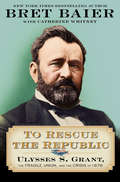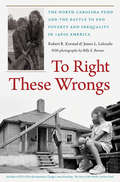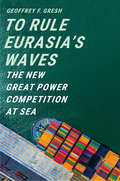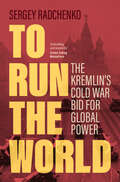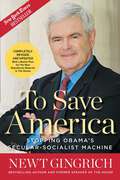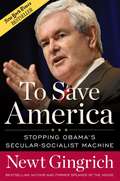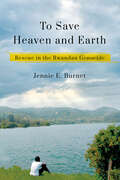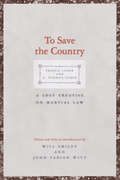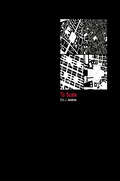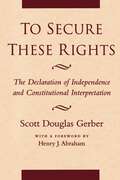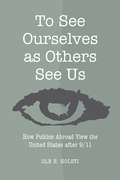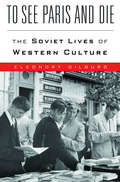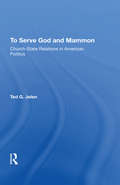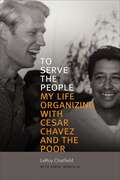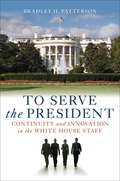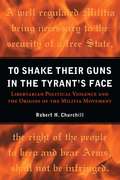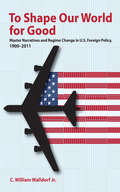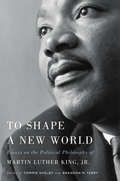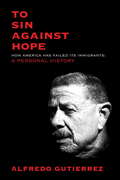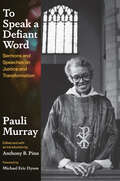- Table View
- List View
To Rescue the Constitution: George Washington and the Fragile American Experiment
by Catherine Whitney Bret Baier#1 New York Times bestselling author Bret Baier reveals how George Washington saved the Constitution–and the American experiment. <p><p> A sweeping narrative ranging from the unsettled early American frontier and the battlefields of the Revolution to the history-making clashes within Philadelphia’s Independence Hall, Bret Baier’s To Rescue the Constitution dramatically illuminates the life of George Washington, the Founder who did more than perhaps any other individual to secure the future of the United States. <p><p> George Washington rescued the nation three times: first by leading the Continental Army to victory in the Revolutionary War, second by presiding over the Constitutional Convention that set the blueprint for the United States and ushering the Constitution through a fractious ratification process, and third by leading the nation as its first president. There is no doubt that the struggling new nation needed to be rescued—and that Washington was the only American who could bring the together. <p><p> After the victorious War of Independence, when a spirit of unity and patriotism might have been expected, instead the nation fractured. The states were no more than a loosely knit and contentious confederation, with no strong central union. It was an urgent matter that led to the calling of a Constitutional Convention to meet in Philadelphia during the summer of 1787. <p><p> Setting aside his plan to retire to Mount Vernon, Washington agreed to be a delegate at Philadelphia. There he was unanimously elected president of the convention. After successfully bringing the Constitution into being, Washington then sacrificed any hope of returning to private life by accepting the unanimous election to be the nation’s first president. Washington was not known for brilliant oratory or prose, but his quiet, steady leadership gave life to the Constitution by showing how it should be enacted. <p><p> In this vivid and moving portrait of America’s early struggles, Baier captures the critical moments when Washington’s leadership brought the nation from the brink of collapse. Baier exposes an early America that is grittier and far more divided than is often portrayed—one we can see reflected in today’s conflicts. <p> <b>New York Times Bestseller</b>
To Rescue the Republic: Ulysses S. Grant, the Fragile Union, and the Crisis of 1876
by Catherine Whitney Bret BaierThe #1 bestselling author and Fox News Channel’s Chief Political Anchor illuminates the heroic life of Ulysses S. Grant. <p><p> An epic history spanning the battlegrounds of the Civil War and the violent turmoil of Reconstruction to the forgotten electoral crisis that nearly fractured a reunited nation, Bret Baier’s To Rescue the Republic dramatically reveals Ulysses S. Grant’s essential yet underappreciated role in preserving the United States during an unprecedented period of division. <p><p> Born a tanner’s son in rugged Ohio in 1822 and battle-tested by the Mexican American War, Grant met his destiny on the bloody fields of the Civil War. His daring and resolve as a general gained the attention of President Lincoln, then desperate for bold leadership. Lincoln appointed Grant as Lieutenant General of the Union Army in March 1864. Within a year, Grant’s forces had seized Richmond and forced Robert E. Lee to surrender. <p><p> Four years later, the reunified nation faced another leadership void after Lincoln’s assassination and an unworthy successor completed his term. Again, Grant answered the call. At stake once more was the future of the Union, for though the Southern states had been defeated, it remained to be seen if the former Confederacy could be reintegrated into the country—and if the Union could ensure the rights and welfare of African Americans in the South. Grant met the challenge by boldly advancing an agenda of Reconstruction and aggressively countering the Ku Klux Klan. In his final weeks in the White House, however, Grant faced a crisis that threatened to undo his life’s work. The contested presidential election of 1876 produced no clear victory for either Republican Rutherford B. Hayes or Democrat Samuel Tilden, who carried most of the former Confederacy. Soon Southern states vowed to revolt if Tilden was not declared the victor. Grant was determined to use his influence to preserve the Union, establishing an electoral commission to peaceably settle the issue. Grant brokered a grand bargain: the installation of Republican Hayes to the presidency, with concessions to the Democrats that effectively ended Reconstruction. This painful compromise saved the nation, but tragically condemned the South to another century of civil-rights oppression. <p><p> Deep with contemporary resonance and brimming with fresh detail that takes readers from the battlefields of the Civil War to the corridors of power where men decided the fate of the nation in back rooms, To Rescue the Republic reveals Grant, for all his complexity, to be among the first rank of American heroes.
To Right These Wrongs: The North Carolina Fund and the Battle to End Poverty and Inequality in 1960s America
by Robert R. Korstad James L. LeloudisWhen Governor Terry Sanford established the North Carolina Fund in 1963, he saw it as a way to provide a better life for the "tens of thousands whose family income is so low that daily subsistence is always in doubt." Illustrated with evocative photographs by Billy Barnes, To Right These Wrongs offers a lively account of this pioneering effort in America's War on Poverty. Robert Korstad and James Leloudis describe how the Fund's initial successes grew out of its reliance on private philanthropy and federal dollars and its commitment to the democratic mobilization of the poor. Both were calculated tactics designed to outflank conservative state lawmakers and entrenched local interests that nourished Jim Crow, perpetuated one-party politics, and protected an economy built on cheap labor. By late 1968, when the Fund closed its doors, a resurgent politics of race had gained the advantage, led by a Republican Party that had reorganized itself around opposition to civil rights and aid to the poor. The North Carolina Fund came up short in its battle against poverty, but its story continues to be a source of inspiration and instruction for new generations of Americans.
To Rule Eurasia’s Waves: The New Great Power Competition at Sea
by Geoffrey F. GreshThe first book to weave Eurasia together through the perspective of the oceans and seas Eurasia’s emerging powers—India, China, and Russia—have increasingly embraced their maritime geographies as they have expanded and strengthened their economies, military capabilities, and global influence. Maritime Eurasia, a region that facilitates international commerce and contains some of the world’s most strategic maritime chokepoints, has already caused a shift in the global political economy and challenged the dominance of the Atlantic world and the United States. Climate change is set to further affect global politics. With meticulous and comprehensive field research, Geoffrey Gresh considers how the melting of the Arctic ice cap will create new shipping lanes and exacerbate a contest for the control of Arctic natural resources. He explores as well the strategic maritime shifts under way from Europe to the Indian Ocean and Pacific Asia. The race for great power status and the earth’s changing landscape, Gresh shows, are rapidly transforming Eurasia and thus creating a new world order.
To Run the World: The Kremlin's Cold War Bid for Global Power
by Sergey RadchenkoWhat would it feel like To Run the World? The Soviet rulers spent the Cold War trying desperately to find out. In this panoramic new history of the conflict that defined the postwar era, Sergey Radchenko provides an unprecedented deep dive into the psychology of the Kremlin's decision-making. He reveals how the Soviet struggle with the United States and China reflected its irreconcilable ambitions as a self-proclaimed superpower and the leader of global revolution. This tension drove Soviet policies from Stalin's postwar scramble for territory to Khrushchev's reckless overseas adventurism and nuclear brinksmanship, Brezhnev's jockeying for influence in the third world, and Gorbachev's failed attempts to reinvent Moscow's claims to greatness. Perennial insecurities, delusions of grandeur, and desire for recognition propelled Moscow on a headlong quest for global power, with dire consequences and painful legacies that continue to shape our world.
To Save America: Stopping Obama's Secular-Socialist Machine
by Newt GingrichNewt Gingrich's New York Times bestseller, To Save America, is now in paperback! Featuring a new chapter and completely updated throughout, To Save America will offer the first critical analysis of the 2010 elections and will reveal what Republicans must do to get the country back on track. "History is repeating itself," says Newt. "Republicans took back the House, just like we did in 1994." Candidly discussing what Republicans did right-and wrong-last time they took back power, To Save America will explain how we can avoid past mistakes and roll back the Obama administration's secular-socialist machine. "The Left is actively working to demolish our core values and beliefs and replace them with their own," declares Gingrich. "How? Through a secular-socialist machine-a corrupt bureaucracy which uses manipulation and dishonesty to steamroll the will of the people and destroy our great nation." In the new paperback edition of To Save America, Gingrich offers concrete strategies for dismantling this machine and replacing it with policies that work. And now that Republicans have regained the House, we have an opportunity we cannot afford to squander.
To Save America: Stopping Obama's Secular-Socialist Machine
by Newt GingrichThe message of this extraordinary election [in November 2010] is clear enough: the American citizenry has rejected the secular dogma, socialist policies, and machine-driven politics that comprise the Obama agenda. Now, the question is whether President Obama and his Democratic Party will accept the will of the people and change the destructive course upon which they have set this country. . . . [F]irst and foremost, Republicans must fight to dislodge the secular-socialist machine whose methods and goals are described in this book. This machine has driven America so deeply into debt, and has so fundamentally changed the relationship between the American citizenry and our government, that our childrenâ??s future is now imperiled. We cannot assume that after the 2010 election, the machine will simply accept the will of the people. After all, the very purpose of a political machine is to thwart the will of the people. - From the introduction
To Save Everything, Click Here: The Folly of Technological Solutionism
by Evgeny MorozovThe award-winning author of "The Net Delusion" shows how the radical transparency we've become accustomed to online may threaten the spirit of real-life democracy
To Save Heaven and Earth: Rescue in the Rwandan Genocide
by Jennie E. BurnetIn To Save Heaven and Earth, Jennie E. Burnet considers people who risked their lives in the 1994 Rwandan genocide of Tutsi to try and save those targeted for killing. Many genocide perpetrators were not motivated by political ideology, ethnic hatred, or prejudice. By shifting away from these classic typologies of genocide studies and focusing instead on hundreds of thousands of discrete acts that unfold over time, Burnet highlights the ways that complex decisions and behaviors emerge in the social, political, and economic processes that constitute a genocide.To Save Heaven and Earth explores external factors, such as geography, local power dynamics, and genocide timelines, as well as the internal states of mind and motivations of those who effected rescues. Framed within the interdisciplinary scholarship of genocide studies and rooted in cultural anthropology methodologies, this book presents stories of heroism and of the good done amid the evil of a genocide that nearly annihilated Rwandan Tutsi and decimated the Hutu and Twa who were opposed to the slaughter.
To Save the Country: A Lost Treatise on Martial Law (Yale Law Library Series in Legal History and Reference)
by Francis Lieber G. Norman LieberA Civil War-era treatise addressing the power of governments in moments of emergency The last work of Abraham Lincoln’s law of war expert Francis Lieber was long considered lost—until Will Smiley and John Fabian Witt discovered it in the National Archives. Lieber’s manuscript on emergency powers and martial law addresses important contemporary debates in law and political philosophy and stands as a significant historical discovery. As a key legal advisor to the Lincoln White House, Columbia College professor Francis Lieber was one of the architects and defenders of Lincoln’s most famous uses of emergency powers during the Civil War. Lieber’s work laid the foundation for rules now accepted worldwide. In the years after the war, Lieber and his son turned their attention to the question of emergency powers. The Liebers’ treatise addresses a vital question, as prominent since 9/11 as it was in Lieber’s lifetime: how much power should the government have in a crisis? The Liebers present a theory that aims to preserve legal restraint, while giving the executive necessary freedom of action. Smiley and Witt have written a lucid introduction that explains how this manuscript is a key discovery in two ways: both as a historical document and as an important contribution to the current debate over emergency powers in constitutional democracies.
To Scale: One Hundred Urban Plans
by Eric JenkinsHow big is Moscow’s Red Square in comparison to Tiananmen Square? Why are there fewer public squares in Japan than in Italy? What lessons might be found in the plan of Savannah, Georgia’s historic district? To Scale is a collection of plans of urban spaces drawn at the same scale to help answer these questions by providing a single and accurate resource of urban plans for architects, urban designers, planners and teachers, and students. The book contains one hundred figure-ground plans from seventy-eight cities around the world, describing an identical area (half a kilometer square) for each urban space. Accompanying each plan are photographs, diagrams and text that illustrate essential aspects of the plan or urban space for the designer. This compilation is an excellent resource helping to visualize, compare and reconceptualize urban design for students wanting to understand the lessons of existing cities and the making of urban spaces.
To Secure These Rights: The Declaration of Independence and Constitutional Interpretation
by Scott Douglas GerberA legal scholar puts forward a rigorous and provocative theory of constitutional interpretation that cuts across today&’s partisan divide.To Secure These Rights enters the fascinating—and often contentious—debate over constitutional interpretation. Scott Douglas Gerber argues that the Constitution of the United States should be interpreted in light of the natural rights political philosophy of the Declaration of Independence and that the Supreme Court is the institution of American government that should be primarily responsible for identifying and applying that philosophy in American life. Importantly, the theory advanced in this book—what Gerber calls liberal originalism—is neither consistently liberal nor consistently conservative in the modern conception of those terms. Rather, the theory is liberal in the classic sense of viewing the basic purpose of government to be safeguarding the natural rights of individuals. As Thomas Jefferson wrote in the Declaration of Independence, to secure these rights, governments are instituted among men. In essence, Gerber maintains that the Declaration articulates the philosophical ends of our nation, and that the Constitution embodies the means to effectuate those ends. Gerber's analysis reveals that the Constitution cannot be properly understood without recourse to history, political philosophy, and law.
To See Ourselves as Others See Us
by Ole R. Holsti"Holsti, the authority on American foreign policy attitudes, investigates others' views of us. It's not pretty. It matters. Read this. " ---Bruce Russett, Dean Acheson Professor of International Relations, Yale University, and editor of theJournal of Conflict Resolution "Clearly and engagingly written, Holsti's book ranks among the most important---and most objective---of the post-9/11 scholarly studies. It deserves a large readership, both within and beyond academe. " ---Ralph Levering, Vail Professor of History, Davidson College In terms of military and economic power, the United States remains one of the strongest nations in the world. Yet the United States seems to have lost the power of persuasion, the ability to make allies and win international support. Why? Immediately after the terrorist attacks of 9/11, leaders and citizens of foreign nations generally expressed sympathy for the United States. Since then, attitudes have changed. Drawing upon public opinion surveys conducted in 30 nations, Ole R. Holsti documents an increasing anti-American sentiment. His analysis suggests that the war in Iraq, human rights violations, and unpopular international policies are largely responsible. Consequently, the United States can rebuild its repute by adopting an unselfish, farsighted approach to global issues. Indeed, the United States must restore goodwill abroad, Holsti asserts, because public opinion indirectly influences the leaders who decide whether or not to side with the Americans. Ole R. Holsti is George V. Allen Professor Emeritus of International Affairs in the Department of Political Science at Duke University and author ofPublic Opinion and American Foreign Policy.
To See Paris and Die: The Soviet Lives of Western Culture
by Eleonory GilburdAfter Stalin died a torrent of Western novels, films, and paintings invaded Soviet streets and homes. Soviet citizens invested these imports with political and personal significance, transforming them into intimate possessions. Eleonory Gilburd reveals how Western culture defined the last three decades of the Soviet Union, its death, and afterlife.
To Serve God And Mammon: Church-state Relations In The United States (Religion And Politics Ser.)
by Ted JelenThis book provides fresh perspective on the origins and persistence of church 8211; state conflict in American political culture, exploring the inherent tension between the Establishment and Free Exercise clauses of the First Amendment.
To Serve the Living: Funeral Directors and the African American Way of Death
by Suzanne E. SmithFrom antebellum slavery to the twenty-first century, African American funeral directors have orchestrated funerals or “homegoing” ceremonies with dignity and pageantry. As entrepreneurs in a largely segregated trade, they were among the few black individuals in any community who were economically independent and not beholden to the local white power structure. Most important, their financial freedom gave them the ability to support the struggle for civil rights and, indeed, to serve the living as well as bury the dead. During the Jim Crow era, black funeral directors relied on racial segregation to secure their foothold in America’s capitalist marketplace. With the dawning of the civil rights age, these entrepreneurs were drawn into the movement to integrate American society, but were also uncertain how racial integration would affect their business success. From the beginning, this tension between personal gain and community service shaped the history of African American funeral directing. For African Americans, death was never simply the end of life, and funerals were not just places to mourn. In the “hush harbors” of the slave quarters, African Americans first used funerals to bury their dead and to plan a path to freedom. Similarly, throughout the long—and often violent—struggle for racial equality in the twentieth century, funeral directors aided the cause by honoring the dead while supporting the living. To Serve the Living offers a fascinating history of how African American funeral directors have been integral to the fight for freedom.
To Serve the People: My Life Organizing with Cesar Chavez and the Poor
by LeRoy ChatfieldThe long pilgrimage of LeRoy Chatfield weaves its way through multiple collective projects designed to better the condition of the marginalized and forgotten. From the cloisters of the Christian Brothers and the halls of secondary education to the fields of Central California and the streets of Sacramento, Chatfield&’s story reveals a fierce commitment to those who were denied the promises of the American dream. In this collection of what the author calls Easy Essays, Chatfield recounts his childhood, explains the social issues that have played a significant role in his life and work, and uncovers the lack of justice he saw all too frequently. His journey, alongside Cesar and Helen Chavez, Marshall Ganz, Bonnie Chatfield, Philip Vera Cruz, and countless others, displays an unwavering focus on organizing communities and expanding their agency. Follow and explore a life dedicated to equality of opportunity for all. May it inspire and guide you in your quest for a fairer and more just society.
To Serve the President
by Bradley H. PattersonNobody knows more about the duties, the difficulties, and the strategies of staffing and working in the White House than Brad Patterson. In To Serve the President, Patterson combines insider access, decades of Washington experience, and an inimitable style to open a window onto closely guarded Oval Office turf. The fascinating and entertaining result is the most complete look ever at the White House and the people that make it work. Patterson describes what he considers to be the whole White House staff, a larger and more inclusive picture than the one painted by most analysts. In addition to nearly one hundred policy offices, he draws the curtain back from less visible components such as the Executive Residence staff, Air Force One and Marine One, the First Lady's staff, Camp David, and many others--135 separate offices in all, pulling together under often stressful and intense conditions. This authoritative and readable account lays out the organizational structure of the full White House and fills it out the outline with details both large and small. Who are these people? What exactly do they do? And what role do they play in running the nation? Another exciting feature of To Serve the President is Patterson's revelation of the total size and total cost of the contemporary White House--information that simply is not available anywhere else.This is not a kiss-and-tell tale or an incendiary expos?. Brad Patterson is an accomplished public administrator with an intimate knowledge of how the White House really works, and he brings to this book a refreshingly positive view of government and public service not currently in vogue. The U.S. government is not a monolith, or a machine, or a shadowy cabal; above all, it is people, human beings doing the best they can, under challenging conditions, to produce a better life for their fellow citizens. While there are bad apples in every bunch, the vast majority of these people ply their trades honestly and earnestly, often in complete anonymity and for modest compensation. This book illuminates their roles, celebrates their service, and paints an eye-opening picture of how things really work on Pennsylvania Avenue.
To Serve the President
by Bradley H. PattersonNobody knows more about the duties, the difficulties, and the strategies of staffing and working in the White House than Brad Patterson. In To Serve the President, Patterson combines insider access, decades of Washington experience, and an inimitable style to open a window onto closely guarded Oval Office turf. The fascinating and entertaining result is the most complete look ever at the White House and the people that make it work.Patterson describes what he considers to be the whole White House staff, a larger and more inclusive picture than the one painted by most analysts. In addition to nearly one hundred policy offices, he draws the curtain back from less visible components such as the Executive Residence staff, Air Force One and Marine One, the First Lady's staff, Camp David, and many others-135 separate offices in all, pulling together under often stressful and intense conditions.This authoritative and readable account lays out the organizational structure of the full White House and fills it out the outline with details both large and small. Who are these people? What exactly do they do? And what role do they play in running the nation? Another exciting feature of To Serve the President is Patterson's revelation of the total size and total cost of the contemporary White House-information that simply is not available anywhere else.This is not a kiss-and-tell tale or an incendiary exposé. Brad Patterson is an accomplished public administrator with an intimate knowledge of how the White House really works, and he brings to this book a refreshingly positive view of government and public service not currently in vogue. The U.S. government is not a monolith, or a machine, or a shadowy cabal; above all, it is people, human beings doing the best they can, under challenging conditions, to produce a better life for their fellow citizens. While there are bad apples in every bunch, the vast majority of these people ply their trades honestly and earnestly, often in complete anonymity and for modest compensation. This book illuminates their roles, celebrates their service, and paints an eye-opening picture of how things really work on Pennsylvania Avenue.
To Shake Their Guns in the Tyrant's Face: Libertarian Political Violence and the Origins of the Militia Movement
by Robert H. ChurchillAfter the bombings of Oklahoma City in 1995, most Americans were shocked to discover that tens of thousands of their fellow citizens had banded together in homegrown militias. Within the next few years, numerous studies and media reports appeared revealing the unseen world of the American militia movement, a loose alliance of groups with widely divergent views. Not surprisingly, it was the movement's most extreme voices that attracted the lion's share of attention. In reality the militia movement was neither as irrational nor as new as it was portrayed in the press, Robert Churchill writes. What bound the movement together was the shared belief that citizens have a right, even a duty, to take up arms against wanton exercise of unconstitutional power by the federal government. Many were motivated to join the movement by what they saw as a rise in state violence, illustrated by the government assaults at Ruby Ridge, Idaho in 1992, and Waco, Texas in 1993. It was this perception and the determination to deter future state violence, Churchill argues, that played the greatest role in the growth of the American militia movement. Churchill uses three case studies to illustrate the origin of some of the core values of the modern militia movement: Fries' Rebellion in Pennsylvania at the end of the eighteenth century, the Sons of Liberty Conspiracy in Civil War-era Indiana and Illinois, and the Black Legion in Michigan and Ohio during the Depression. Building on extensive interviews with militia members, the author places the contemporary militia movement in the context of these earlier insurrectionary movements that, animated by a libertarian interpretation of the American Revolution, used force to resist the authority of the federal government. A historian of early America, Robert H. Churchill has published numerous articles on American political violence and the right to keep and bear arms. He is currently Associate Professor of History at the University of Hartford. "This book is about how we think about the past, how cultural memories are formed and evolve, and how these memories then come to impact current understandings of issues. Churchill provides an enlightening analysis of the ideology, structure, and purpose of the militia movement. Where much scholarship has categorized it as a cohesive, single movement, Churchill begins the process of unraveling its complexity. " ---Steve Chermak, Michigan State University"To Shake Their Guns in the Tyrant's Faceaddresses an area---the relationship of American political violence to American ideology---that is of growing importance and that is commanding an ever increasing audience, and it does so in a way like nothing else in the field. " ---David Williams, Indiana University Bloomington
To Shape Our World for Good: Master Narratives and Regime Change in U.S. Foreign Policy, 1900–2011
by C. William Walldorf Jr.Why does the United States pursue robust military invasions to change some foreign regimes but not others? Conventional accounts focus on geopolitics or elite ideology. C. William Walldorf, Jr., argues that the politics surrounding two broad, public narratives—the liberal narrative and the restraint narrative—often play a vital role in shaping US decisions whether to pursue robust and forceful regime change.Using current sociological work on cultural trauma, Walldorf explains how master narratives strengthen (and weaken), and he develops clear predictions for how and when these narratives will shape policy. To Shape Our World For Good demonstrates the importance and explanatory power of the master-narrative argument, using a sophisticated combination of methods: quantitative analysis and eight cases in the postwar period that include Korea, Vietnam, and El Salvador during the Cold War and more recent cases in Iraq and Libya. The case studies provide the environment for a critical assessment of the connections among the politics of master narratives, pluralism, and the common good in contemporary US foreign policy and grand strategy. Walldorf adds new insight to our understanding of US expansionism and cautions against the dangers of misusing popular narratives for short-term political gains—a practice all too common both past and present.
To Shape a New World: Essays on the Political Philosophy of Martin Luther King, Jr.
by Tommie ShelbyOn the 50th anniversary of Martin Luther King, Jr.’s, assassination, his political thought remains underappreciated. Tommie Shelby and Brandon Terry, along with a cast of distinguished contributors, engage critically with King’s understudied writings on a wide range of compelling, challenging topics and rethink the legacy of this towering figure.
To Sin Against Hope
by Alfredo GutierrezAlfredo Gutierrez's father, a US citizen, was deported to Mexico from his Arizona hometown--the mining town where Alfredo grew up. This occurred during a wave of anti-immigrant hysteria stoked by the Great Depression, but as Gutierrez makes clear, in a book that is both a personal chronicle and a thought-provoking history, the war on Mexican immigrants has rarely abated. Barack Obama now presides over an immigration policy every inch the equal of Herbert Hoover's in its harshness.His family experiences inspired Gutierrez to pursue the life of a Chicano activist. Kicked out of Arizona State University after leading a takeover of the president's office, he later became the majority leader of the Arizona State Senate. Later still, he was a successful political consultant. He remains an activist, and in this engrossing memoir and essay, he dissects the racism that has deformed a century of border policy--leading to a record number of deportations during the Obama presidency--and he analyzes the timidity of today's immigrant advocacy organizations. To Sin Against Hope brings to light the problems that have prevented the US from honoring the contributions and aspirations of its immigrants. It is a call to remember history and act for the future.
To Speak a Defiant Word: Sermons and Speeches on Justice and Transformation
by Pauli MurrayTwenty-five years of writings by the religious thinker and activist Pauli Murray The religious thought and activism that shaped the late twentieth century is typically described in terms of Black men from the major Black denominations, a depiction that fails to account for the voices of those who not only challenged racism but also forced a confrontation with class and gender. Of these overlooked voices, none is more important than that of Pauli Murray (1910–1985), the nonbinary Black lawyer, activist, poet, and Episcopal priest who influenced such icons as Ruth Bader Ginsburg and Thurgood Marshall. Anthony B. Pinn has collected Murray&’s most important sermons, lectures, and speeches from 1960 through 1985, showcasing her religious thought and activism as well as her original and compassionate literary voice. In highlighting major themes in Murray&’s writing—including the strength and rights of women, faithfulness, religious community, and suffering—Pinn&’s collection reveals the evolution in Murray&’s religious ideas and her sense of ministry, unpacking her role in a tumultuous period of American history, as well as her thriving legacy.
To Speak the Truth: Why Washington's 'Cold War' Against Cuba Doesn't End
by Ernesto Che Guevara Fidel Castro Mary-Alice WatersIn historic speeches before the United Nations and UN bodies, Guevara and Castro address the peoples of the world, explaining why the U. S. government so fears the example set by the socialist revolution in Cuba and why Washington's effort to destroy it will fail. The time to speak the truth has come.... The government of the United States cannot be on the side of peasants because it is an ally of the landowners. It cannot be on the side of workers anywhere in the world because it is an ally of the monopolies. It cannot be on the side of colonies because it is an ally of the colonizing powers. Fidel Castro 1960 Cuba is one of the trenches of freedom in the world. We are situated only a few steps away from the U. S. imperialism, but we have shown by our actions, by our daily example, that in the present conditions of humanity the people can liberate themselves and keep themselves free. Ernesto Che Guevara 1964 In January 1959 a revolutionary government came to power in Cuba, in the more than a half century of U. S. domination of the island. Since then the government of the United States has sustained not only a "cold war" punctuated by invasion, sabotage, and assassination attempts, but also a draconian economic embargo against its Caribbean neighbor. Why this implacable hostility? Why this unremitting economic pressure that has no parallel in modern times? The reason for this policy -- and why it will fail -- are nowhere explained to the peoples of the world more clearly than in these speeches delivered over a span of twenty years before the forum of the United Nations by the most authoritative representatives of the Cuban revolution, Fidel Castro and Ernesto Che Guevara.

